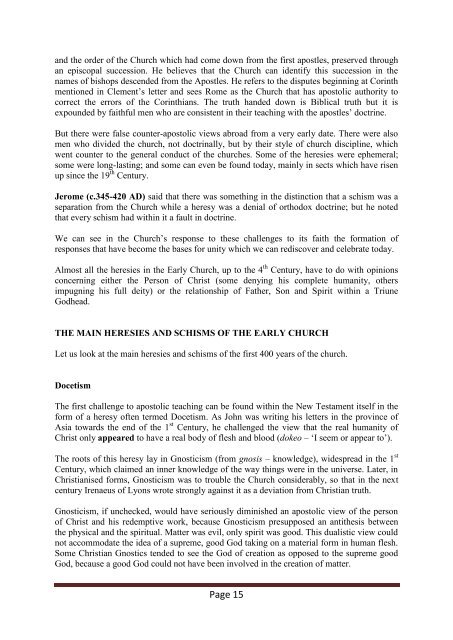Digging Out the Embedded Church - The Maranatha Community
Digging Out the Embedded Church - The Maranatha Community
Digging Out the Embedded Church - The Maranatha Community
You also want an ePaper? Increase the reach of your titles
YUMPU automatically turns print PDFs into web optimized ePapers that Google loves.
and <strong>the</strong> order of <strong>the</strong> <strong>Church</strong> which had come down from <strong>the</strong> first apostles, preserved through<br />
an episcopal succession. He believes that <strong>the</strong> <strong>Church</strong> can identify this succession in <strong>the</strong><br />
names of bishops descended from <strong>the</strong> Apostles. He refers to <strong>the</strong> disputes beginning at Corinth<br />
mentioned in Clement‟s letter and sees Rome as <strong>the</strong> <strong>Church</strong> that has apostolic authority to<br />
correct <strong>the</strong> errors of <strong>the</strong> Corinthians. <strong>The</strong> truth handed down is Biblical truth but it is<br />
expounded by faithful men who are consistent in <strong>the</strong>ir teaching with <strong>the</strong> apostles‟ doctrine.<br />
But <strong>the</strong>re were false counter-apostolic views abroad from a very early date. <strong>The</strong>re were also<br />
men who divided <strong>the</strong> church, not doctrinally, but by <strong>the</strong>ir style of church discipline, which<br />
went counter to <strong>the</strong> general conduct of <strong>the</strong> churches. Some of <strong>the</strong> heresies were ephemeral;<br />
some were long-lasting; and some can even be found today, mainly in sects which have risen<br />
up since <strong>the</strong> 19 th Century.<br />
Jerome (c.345-420 AD) said that <strong>the</strong>re was something in <strong>the</strong> distinction that a schism was a<br />
separation from <strong>the</strong> <strong>Church</strong> while a heresy was a denial of orthodox doctrine; but he noted<br />
that every schism had within it a fault in doctrine.<br />
We can see in <strong>the</strong> <strong>Church</strong>‟s response to <strong>the</strong>se challenges to its faith <strong>the</strong> formation of<br />
responses that have become <strong>the</strong> bases for unity which we can rediscover and celebrate today.<br />
Almost all <strong>the</strong> heresies in <strong>the</strong> Early <strong>Church</strong>, up to <strong>the</strong> 4 th Century, have to do with opinions<br />
concerning ei<strong>the</strong>r <strong>the</strong> Person of Christ (some denying his complete humanity, o<strong>the</strong>rs<br />
impugning his full deity) or <strong>the</strong> relationship of Fa<strong>the</strong>r, Son and Spirit within a Triune<br />
Godhead.<br />
THE MAIN HERESIES AND SCHISMS OF THE EARLY CHURCH<br />
Let us look at <strong>the</strong> main heresies and schisms of <strong>the</strong> first 400 years of <strong>the</strong> church.<br />
Docetism<br />
<strong>The</strong> first challenge to apostolic teaching can be found within <strong>the</strong> New Testament itself in <strong>the</strong><br />
form of a heresy often termed Docetism. As John was writing his letters in <strong>the</strong> province of<br />
Asia towards <strong>the</strong> end of <strong>the</strong> 1 st Century, he challenged <strong>the</strong> view that <strong>the</strong> real humanity of<br />
Christ only appeared to have a real body of flesh and blood (dokeo – „I seem or appear to‟).<br />
<strong>The</strong> roots of this heresy lay in Gnosticism (from gnosis – knowledge), widespread in <strong>the</strong> 1 st<br />
Century, which claimed an inner knowledge of <strong>the</strong> way things were in <strong>the</strong> universe. Later, in<br />
Christianised forms, Gnosticism was to trouble <strong>the</strong> <strong>Church</strong> considerably, so that in <strong>the</strong> next<br />
century Irenaeus of Lyons wrote strongly against it as a deviation from Christian truth.<br />
Gnosticism, if unchecked, would have seriously diminished an apostolic view of <strong>the</strong> person<br />
of Christ and his redemptive work, because Gnosticism presupposed an anti<strong>the</strong>sis between<br />
<strong>the</strong> physical and <strong>the</strong> spiritual. Matter was evil, only spirit was good. This dualistic view could<br />
not accommodate <strong>the</strong> idea of a supreme, good God taking on a material form in human flesh.<br />
Some Christian Gnostics tended to see <strong>the</strong> God of creation as opposed to <strong>the</strong> supreme good<br />
God, because a good God could not have been involved in <strong>the</strong> creation of matter.<br />
Page 15








